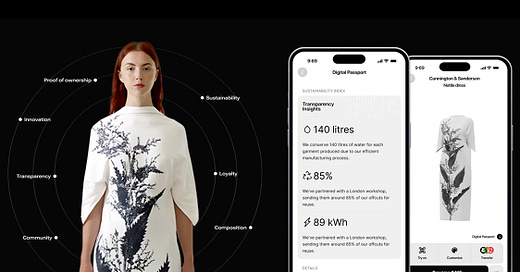Fashion's Untold Stories
Cunnington and Sanderson’s Wardrobe for the Anthropocene Now Presented In a Radical New Exhibition
Sometimes, gazing into the future of fashion means taking a step back and allowing heritage to meet innovation, shaping a radically immersive fashion concept. In that sense, Wearing Sustainability: Untold Stories from Historical, Contemporary & Digital Fashion is not just an exhibition; it's a transformative experience.Curated by the avant-garde design duo Cunnington & Sanderson, alongside Dr. Anja Connor-Crabb from the School of Design, University of Leeds, Elaine Evans, Yorkshire Fashion Archive, and Alexandra Maslova from SEAMM.
Matthew Cunnington & John Sanderson met while studying fashion design at the University of Central England with their shared love of draping the new directly upon the mannequin. Founded in 2012, the independent label has presented at catwalk shows and showrooms at London, Milan, and Paris fashion week and exhibited around the world, including Barcelona, France, and Brussels, and locally in the UK at Lotherton Hall and Bankfield Museum. Awards include winning the International Festival of fashion, photography and Accessories in Hyeres, France, the On|Off Landrover Visionary Award, and NEWGEN in London, and finalist for the Mango Fashion Awards for 2 consecutive years. You can easily say they are doing something extremely right.
This venture marks a milestone in their unique career. Carefully selected, each exhibition piece tells a story of sustainability, craftsmanship, and many promising technological advancements. From the rich archives of the Yorkshire Fashion Archive to the pioneering designs of BA Fashion Design Innovation students. and the emotionally charged designs of the creative duo, this exhibition runs as a fashion fairytale for the soul. We sat down with John Sanderson to discuss the hows and whys in a chat that easily transcended mere interviewing.
"Untold stories" is a powerful phrase—what kinds of stories did you feel needed telling through this exhibition?. What brought you to combine archival fashion, your designs, and digital elements for this exhibition?
It all started with the question: how do we connect stories across time? Sustainability became the thread that tied everything together. That’s where the idea of inviting the Yorkshire Fashion Archive came in. They hold a lot of historical garments, mainly from Yorkshire, and we wanted to delve into their collection to select pieces that deserved to be seen again, reimagined for the present.
We’ve also collaborated with SEAMM, the digital platform, to create digital wearables based on our fashion pieces. So it made sense to combine these three dimensions — the historical, the contemporary, and the future. We've actually digitised some of the archive pieces so that visitors can interact with them through try-on technology.


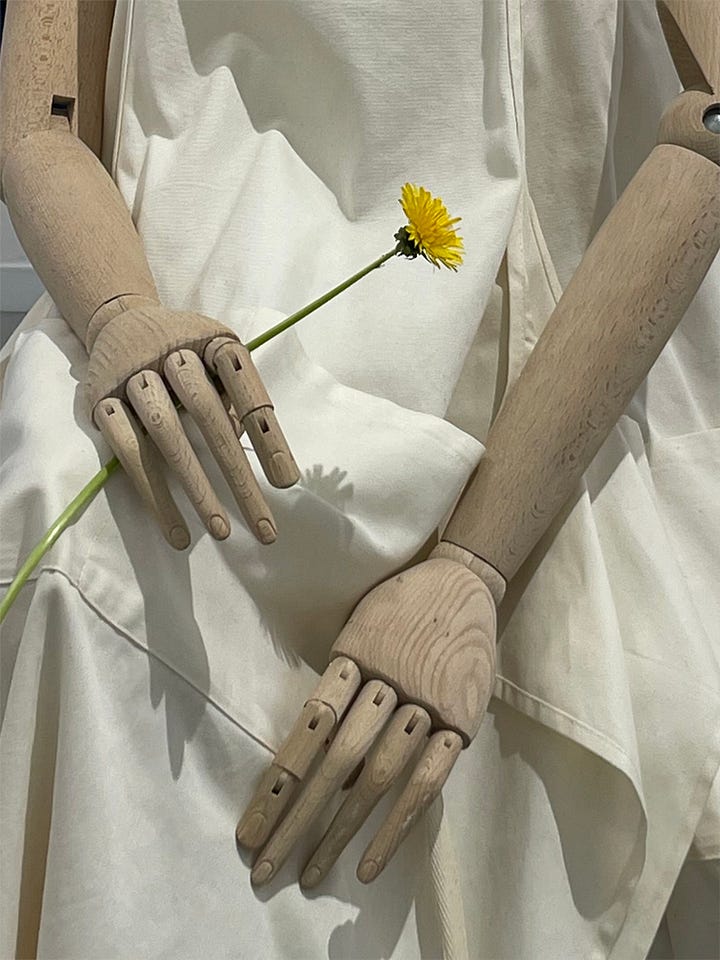
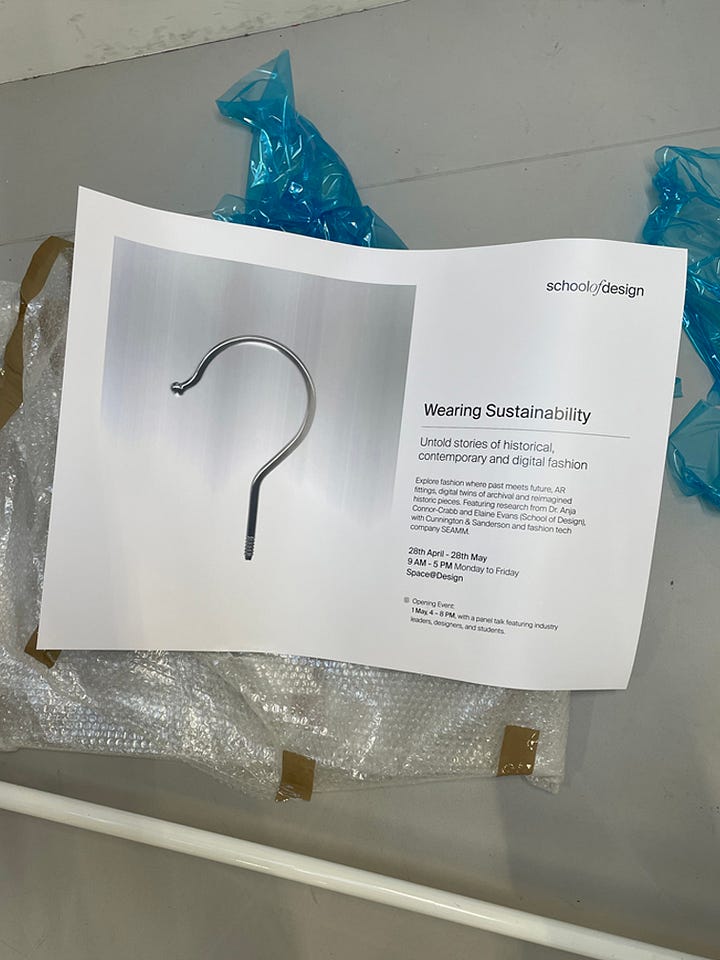
That’s fascinating — almost like bringing historical fashion back to life. It becomes active again.
Exactly. It gives new life to pieces that would otherwise be protected or hidden away. This way, we can show the details and stories in a way that’s rarely possible in traditional formats. Usually, people just see a garment in a shop or on a hanger — the story behind it is completely missing. The exhibition lets us go deeper.
That brings us to the title: Untold Stories. You're telling the hidden narratives behind clothes, right?
That’s right. Whether it’s historical or futuristic, we wanted visitors to engage more deeply. For example, some of our pieces use a digital product passport — it's embedded in the fabric — so people can access information like where the fabric came from, how it was made, and its sustainability credentials. It’s a rich and accessible resource.
Some people might say, “I like a piece, I wear it, end of story.” Why do you think it’s important to know the background?
For us, it’s about connection. Why do you cherish one t-shirt over another? Maybe it’s been personalized. Or maybe it has a story you relate to — something emotional, something physical. That story becomes the bond. As designers, that’s incredibly meaningful.
I was struck by how emotional your exhibition feels, even though it uses tech like AR and digital fashion. We don’t often think of technology and sustainability as working together, but you seem to have bridged that gap.
Yes — one great example is the AR try-on feature. It’s not about replacing the tactile experience, but enhancing it. It helps reduce waste. People can “try on” garments in their own space before buying, which cuts down on unnecessary orders and returns. It’s better for the carbon footprint and allows for more conscious consumption. More informed choices mean deeper connections.
‘This is more than a display of garments, it’s a showcase of hidden histories, digital innovation, and sustainable design.”
Cunnington & Sanderson
And you’re encouraging public interaction online as well?
Yes, we wanted people beyond the exhibition space to participate. There’s a digital try-on competition: visitors can download the brand's free app on Apple store or Google Play. Search for Cunnington & Sanderson x Seamm, and through your mobile phone, instantly try on a digital garment, post a photo using the hashtag #WearingSustainabilityExhibition. We’ll share the posts, and some of them will be featured in the exhibition space itself.
That’s brilliant. I saw some of your key pieces online — the Pillow Dress, the Zero Dress, and the Gown of Care — and they all seem to blend conceptual storytelling with craft. How did you choose what to feature?
We curated a collection that showed a range of sustainable practices. Since 2012, we've developed our own zero-waste draping technique — everything is done by hand directly onto mannequins, which ensures each piece is unique.
The Pillow Dress, for instance, is gender-neutral and part of a community-based project. It travels from one storyteller to another around the world. They add their story, then pass it on. It’s about shared authorship and emotional connection to raise Mental Health Awareness.
The Zero Dress showcases our zero-waste methods, printed in the UK using eco-friendly pigments, low-energy processes, and zero water waste.
The Gown of Care was created with PPE Refashioned, using discarded medical gowns that would otherwise be thrown away after 75 washes. We draped each gown individually, so the final piece looks voluminous and high-fashion, but no fabric was wasted. It’s completely transformed from a symbol of clinical protection into something expressive and bold.
That one is stunning. It’s the voluminous blue gown with the white straps, right?
Yes, exactly. We wanted it to look as if the gowns were suspended, capturing that motion of being lifted from the floor — no longer waste, but reborn.


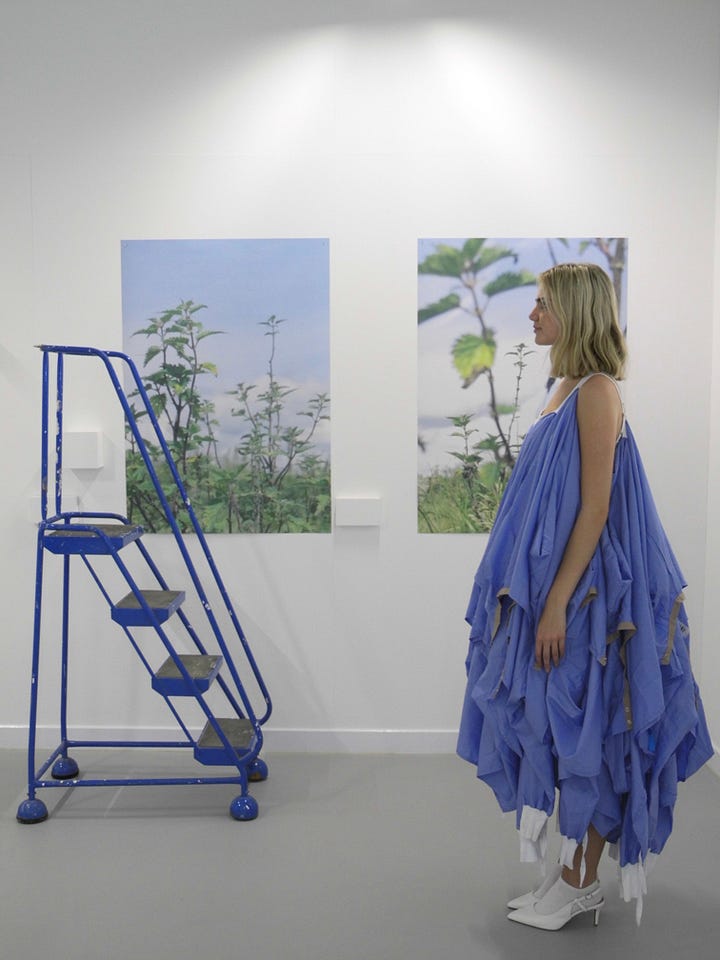
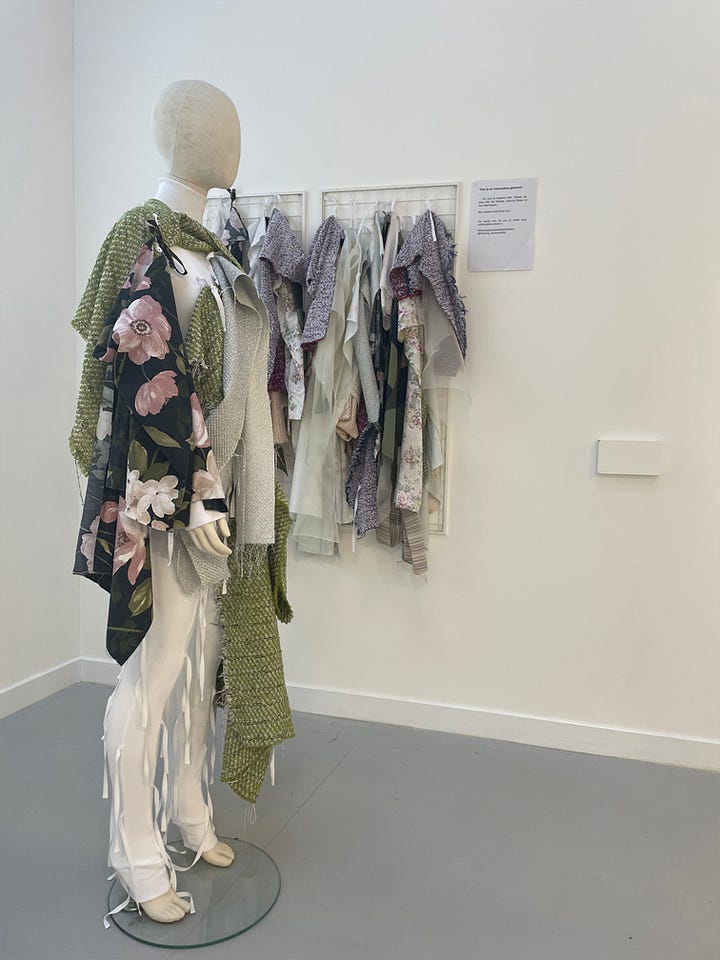
There's also an interactive piece you haven’t mentioned yet — something where visitors can get hands-on?
That’s The Redress, a piece that invites visitors to physically engage. There’s a mannequin dressed in a bodysuit, and behind it hangs deadstock fabric supported by ourselves, including some of our old prints and fabrics, Linton Tweeds couture woven tweeds, and Amber Dean fashion design student, with work on display.
It’s playful but also educational — a reminder that anyone can participate in fashion-making, even without formal training. It inspires people to upcycle or repair their own garments at home. The idea is to demystify the process and make it accessible.
It sounds like you’ve created an environment that’s more than an exhibition — it’s immersive, almost like a set design.
That’s exactly how we approached it. The mannequins are deliberately positioned to raise questions. They’re not just props to display clothes — they’re part of the storytelling. Everything is curated to prompt reflection: what are we wearing, where did it come from, and how can we be more sustainable? In that sense, it’s meant to be both thought-provoking and enjoyable.
Editor’s note:
The Wearing Sustainability: Untold Stories exhibition is currently on view. Visitors can experience the future of fashion through digital try-ons, storytelling garments, and participatory installations. For more, follow the hashtag #WearingSustainabilityExhibition and try on a piece yourself via QR code.


